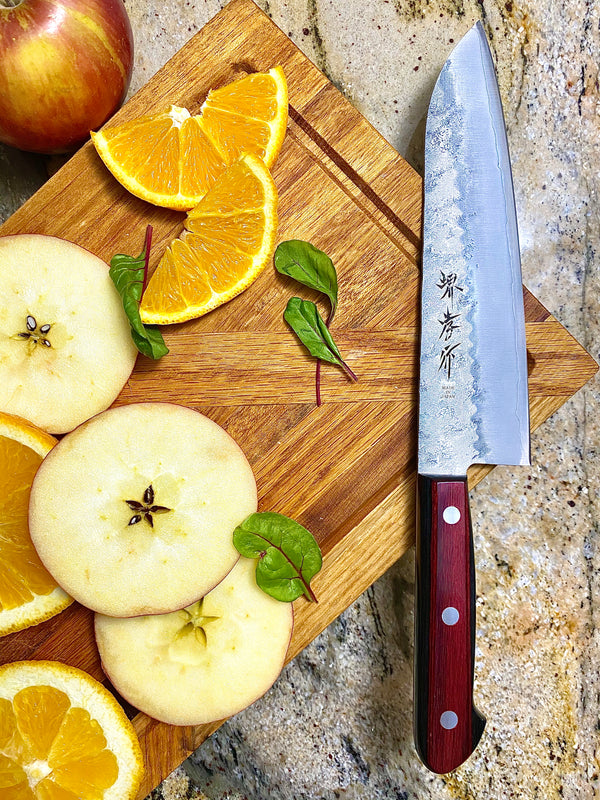Your Cart is Empty
by Ryan Shaffer June 12, 2021 4 min read
![What are Yanagiba Knives Used for? [Updated 4/26/2022]](http://hasuseizo.com/cdn/shop/articles/Shobu_Shirogami_Hasu-Seizo_Saika_Takayuki_1600x.jpg?v=1623513272)
So, you’ve decided to dive into the rabbit hole of Japanese sushi knives!
There are quite a few different options, including as you may have guessed, the Yanagiba knife. While many knives can be used to cut fillets of fish and create beautiful sashimi, there are a few different knife styles that are designed specifically for precise slicing of seafood. The Yanagiba being the focus of this article, however the Takohiki and the Sujihiki and are other knives that can be used for similarly spectacular results.
Yanagiba literally means Willow Leaf. While Eastern Japan, the Tokyo region, uses the name "Yanagiba" for this style of slicer knife, Western Japan in the Osaka and Kyoto regions refer to the same knife as the Shobu. Thus, Yanagiba and Shobu are interchangeable names for the same knife. The shape is a slim blade which looks like a Katana (sword), suitable for slicing tasks.
Originating in Western Japan, sushi knives such as the Yanagiba have a long heritage. Both names translate to leaves, Yanagiba translating to Willow Leaf and with Shobu being Iris Leaf, both of which imbue the flexible and effective nature of this slicing blade. The Yanagiba knives would quickly spread throughout Japan as one of the more desired sushi knives on the market.
The Yanagiba knife is an incredibly important tool in kitchens worldwide. The sushi knife is ideal due to its single bevel design, generous length, coupled with a slim shape and light weight. Traditionally made out of carbon steel, Yanagiba knives can slice seafood with ease, leaving a pristine cut that is pleasing to the eye as well as the taste buds. Due to these characteristics Shobu knives are the perfect sushi knife for working with all types of fish, octopus, and other seafood.
Originating from the ancient art of Japanese sword making, individuals can incorporate similarly impressive kitchen tools to their home by shopping for hand forged Shobu knives made by talented craftsmen. First originated in Western Japan in Osaka and Kyoto, the sushi knife would become a household item because of the work of master blacksmiths like Doi-san at Sakai Takayuki. Sakai Takayuki has followed a 600-year history of crafting artisan Shobu Knives for clients around the world.
The Yanagiba knife has been admired for its ease of use with boneless fish, but there are a variety of other advantages that the blade can provide. Check out these Yanagiba knife characteristics:
Of the different Japanese kitchen knives out there, the Yanagiba knife is by far one of the longer knives available. While it is long, it is also slender, allowing for minimal surface area to create friction while slicing the seafood. The length allows for minimal back and forth when slicing a piece of sashimi, optimally only one motion.
Like many Japanese kitchen knives, the Yanagiba knife is created in a variety of steel types. High-end traditional Japanese knives are typically made out of Shirogami, also known as White Steel. However, the Yanagiba, as with other sushi knives, can also be found in Stainless Steel versions. Both have their benefits. Check out our Material Types page for more info. Ultimately it is entirely a personal choice and cooking style. Many traditional Japanese chefs prefer the Shirogami due to the razor-sharp edge that is achievable. With the razor-sharp edge, the blade slices through the fish with ease which creates less damage to the meat.
While Yanagiba Knives may look intimidating, once you try them out, they are a breeze to use and they are crafted by master blacksmiths to last!! Following proper maintenance and sharpening techniques will allow buyers to get the most out of their Yanagiba knives while also increasing the longevity of knives. Check out our blog How to Make Your Japanese Kitchen Knives Last Longer for more tips and tricks.
Hasu-Seizo is a family-owned and operated business proud to offer handcrafted artisan Japanese knives to clients throughout the greater Seattle region as well as the rest of the world. Hasu-Seizo came to life out of an affinity for family history and the work performed on Sakai Takayuki brand blades in Osaka. Shop authentic Yanagiba knives with Hasu-Seizo today.

by Ryan Shaffer September 14, 2023 4 min read

by Ryan Shaffer September 07, 2023 5 min read

by Ryan Shaffer August 31, 2023 5 min read

Subscribe to get 10% off your first order in addition to our monthly newsletter which gets you first dibs on newly arrived knives, custom designs, and special offers. Discount can not be combined with other seasonal discounts.